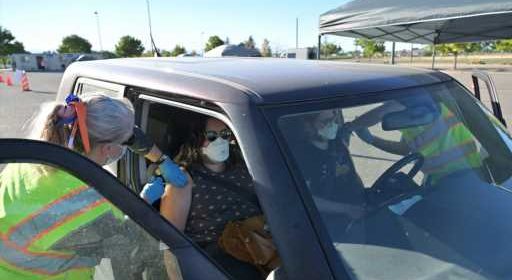Colorado’s numbers suggest increasing COVID infections

The signs seem to point to a rise in COVID-19 infections in Colorado, but fuzziness in the data makes it difficult to say what’s happening with certainty.
As of Tuesday, the state’s wastewater dashboard showed virus concentrations were rising in 23 areas, falling in 12 and flat in 21. The increases were relatively small, however, and could reflect fluctuations from sampling, said Talia Quandelacy, an assistant professor of epidemiology at the Colorado School of Public Health.
“I think it’s a little bit early to say definitively,” she said.
About 8.9% of COVID-19 tests came back positive over the last week, up from about 6.8% a week earlier. Normally, when the percentage of tests coming back positive starts rising, it’s a clear sign that increases in cases and hospitalizations will follow. The number of people getting tested has dropped recently, however, so the change may at least partially reflect that those seeking out a test think there’s a good chance they could have COVID-19.
Cases rose for a second week, with 4,721 confirmed new infections reported in the week ending Sunday. That’s 430 more than in the previous week.
Hospitalizations were essentially unchanged. The Colorado Department of Public Health and Environment reported 183 people were hospitalized statewide with COVID-19 as of Tuesday afternoon, which was four more than at the same point a week earlier. Roughly two-thirds of people hospitalized with COVID-19 are there primarily for the virus.
It’s a good idea to get your booster if you haven’t had it yet and to get tested if you feel sick, especially since infections may be increasing, Quandelacy said. While tools are available to reduce the odds of hospitalization, it’s better to avoid infection and the threat of long COVID, particularly heading into respiratory virus season, she said.
Seven Colorado counties were at the medium risk level on the Centers for Disease Control and Prevention’s dashboard, based on their hospitalizations and cases: Alamosa, Conejos, Costilla, Mineral, Montezuma, Rio Grande and Saguache. All but 11 counties were considered to have substantial or high transmission, however, based on their case counts and the percentage of tests coming back positive.
Nationwide, cases and hospitalizations have stopped dropping, though that obscures significant variation, according to data compiled by The New York Times. Hospitalizations have risen most over the last two weeks in New Mexico, Hawaii, Vermont and Wyoming, while they’ve dropped in the South.
Colorado’s modeling team projected that hospitalizations would continue to decline if there isn’t a variant that’s sufficiently different from BA.5, which was firmly on top when they put out the latest report, Quandelacy said.
As of Oct. 2, BA.5 still was found in about 76% of samples sent for genetic sequencing, according to the state health department. Other variants that showed up included BA.4.6, 13%; BF.7, 6%; and BQ.1, 4%. All of the subvariants that are relevant at the moment are offshoots of omicron that have developed mutations to better evade the immune system.
BA.5’s dominance is continuing to fade nationwide, though it still accounts for about 62% of cases, according to estimates from the CDC. BQ.1.1 continued doubling its share every week, increasing to about 7.2% of cases. BQ.1 and BF.7 also increased their shares.
It’s not yet clear if any of the variants are more worrisome than any others, Quandelacy said.
“Right now, it’s hard to tell which is taking over a little bit faster,” she said.
Subscribe to bi-weekly newsletter to get health news sent straight to your inbox.
Source: Read Full Article